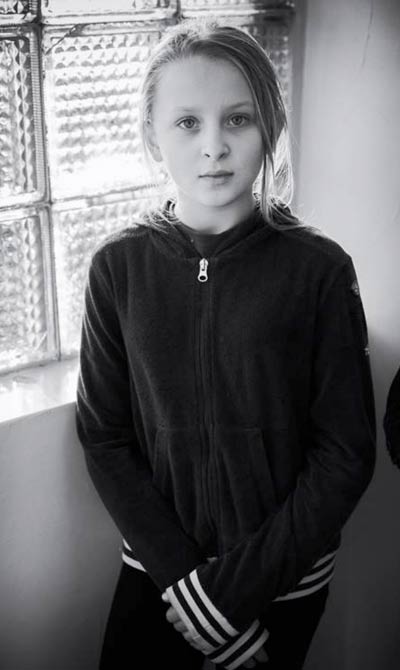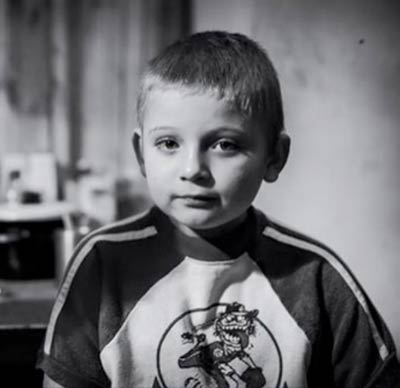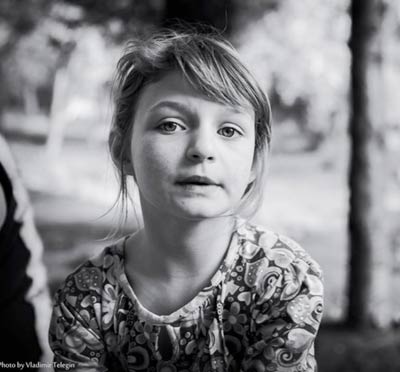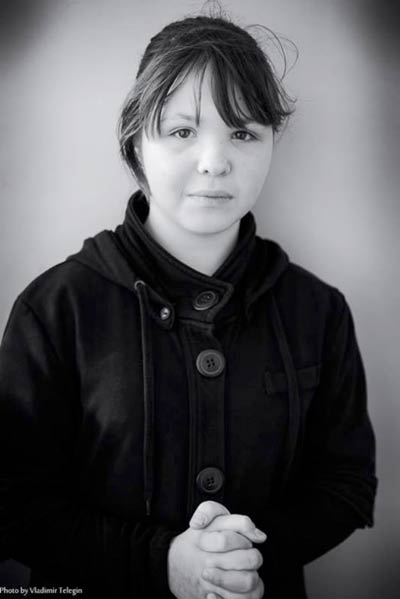Over the past several months, the thrice-weekly Russian newspaper Novaya Gazeta has featured five photo stories about children in the war zone of eastern Ukraine. There are three more reports to come, said the series creator, Yan Shenkman, a journalist in Moscow and a contributor to Novaya Gazeta, in an email.
“The idea of our project is quite simple – we take pictures of children affected by the conflict in Ukraine, and tell their stories. No analysis, no political showdown, only their stories. Monologues, for the most part,” Shenkman told Truthout.
“The idea came from a friend, a writer and political activist Maxim Gromov. He had already worked on a similar project – ‘The Children of Prisoners,'” Shenkman added.
“The aim of the project is to show that because of the conflict, the most vulnerable parts of the population suffer.”
“The second participant in our project is well-known St. Petersburg photographer Vladimir Telegin. I offered the idea to the editor-in-chief of Novaya Gazeta, Dmitry Muratov. That’s how ‘The Children of War’ became a special project of the Novaya Gazeta. We have published five reports so far. There will be three more.”
“After that,” Shenkman continued, “I created a Facebook group to post the articles, photos and notes which were not included in the published reports in Novaya Gazeta. Soon, the group began to receive photos and notes from people who are doing similar things as well as posts of volunteers who work with children. I block any attempts at hate speech or aggressive expression in the Facebook group.”
“We made three trips for the project – to the Rostov region of Russia, where we visited the refugee camps; to Donetsk city and the surrounding area; and thirdly to Slavyansk, Melitopol and Kharkiv which also have refugee camps. Volunteers from both sides helped us a great lot. If not for them, the whole thing wouldn’t have worked.”
Shenkman explained: “The aim of the project is to show that because of the conflict, the most vulnerable parts of the population suffer. And people are suffering on both sides. Children and their parents often don’t even realize who and why is fighting and who is shooting at them.”
“We were struck by the evident contrasts. In city centers of the war zones, there are cafes, shops, well-dressed people, expensive cars. But just half an hour’s drive away, there are frightened children and elderly people living often without electricity, without food or proper clothing,” he added.
“I don’t believe that anyone behind this war would truly come to their senses while looking at these photos and reading the stories. But at least they won’t be able to say they were not aware.”
“To help them is very simple, but for some reason, nobody or almost nobody seems to care. This is what we observed in all three trips: in the town of Shakhty [Rostov region of Russia], in Donetsk (which, additionally, had been severely bombed) and in Kharkiv. Everything is very much alike on both sides of the frontline.”
“I don’t believe that anyone behind this war would truly come to their senses while looking at these photos and reading the stories. But at least they won’t be able to say they were not aware.”
“In my opinion, at present, regardless of who started the war and who is to blame, both sides of the conflict have their arms in blood up to their elbows. In this war, there is no right side or wrong side. There are criminals and there are victims. We talk with victims and speak about them. It is useless to talk to the criminals.”
“There is yet another reason why we are doing this. Russian society (I can’t talk about Ukrainian society, since I don’t live there) is in a deep moral decay. Whatever you are doing – politics, business, even art – everything is upside down and has a bad smell. Assistance to victims is one of the few good and right things to be doing now. I won’t comment about numerous other things that people are doing. The only moral act right now is to see that killing people is a bad thing, whoever commits it and for whatever aims. Meanwhile, helping people is clearly a good thing. We work to remind people about this moral rule.”
Meet the Children of War-Torn Donbas
Here is a selection of the photos and stories of children from the Novaya Gazeta “Children of War” series and the Facebook group of the same name. The stories have been translated from the original Russian by NewColdWar.org. Photos are reproduced with permission.
 Alonya* Alyona, 13 years old
Alonya* Alyona, 13 years old
Alyona and her family lived in the village of Peski, close to a military factory. The site was among the first to be bombed. The family fled to the city of Donetsk, where they live in a shelter for displaced families.
“Once after the bombing, I had a nightmare. I dreamed that my mother was drafted to the levy as a nurse and I was left alone. It’s very frightening without my mother. I can’t be without her.”
When asked what she wants to do when she grows up, Alyona said, “In my childhood, I wanted to become a veterinarian. But now I’m afraid of blood, very afraid. With this war, I do not know who I can become at all.”
Alyona was asked if her family thought of moving to Russia. “Yes, we did. We were going to leave, but then the ferocious shelling started and we decided to wait. We waited and waited, and ended up staying. Mom said, ‘Who needs us in that country? What would we do there?’ It’s true. Here, at least, I know some people.”
* Nikita, 7 years old
 NikitaNikita’s 7th birthday party took place in the refugee shelter where he lives. He received a present that was put aside beforehand from a humanitarian aid package – a toy car. The party was a lot of fun. A group of Roma who are also hiding in this shelter sang songs for Nikita and danced a little. Three languages were spoken at this birthday party – Russian, Ukrainian and Romani.
NikitaNikita’s 7th birthday party took place in the refugee shelter where he lives. He received a present that was put aside beforehand from a humanitarian aid package – a toy car. The party was a lot of fun. A group of Roma who are also hiding in this shelter sang songs for Nikita and danced a little. Three languages were spoken at this birthday party – Russian, Ukrainian and Romani.
“Then we ate cake,” Nikita said. “It wasn’t a real cake, though – mum put jam over bread and said that this is a cake for the celebration.” And celebrate they did.
* Anastasia, 11 years old
“My girlfriend Sasha was killed; she was my best friend. They were traveling by car. A diversionary group came running out of bushes; they started shooting, and Sasha got shot in the head. She was covering her younger brother, who was 2 months old at that time.”
“When they told me about it, I asked, ‘How could this happen?’ It happened, and that is it. Sasha was operated on; she fell into a coma, which lasted all night. She died at dawn.”
“When they bombed us, there was no shelter around, only a basement, where I stayed for 24 hours. Mice and rats [were] everywhere; it was cold.”
“Housing blocs in our neighborhood are four stories. All I could think of throughout this time was that they are going to hit the building and the whole thing will collapse on me. I was afraid to sleep. I didn’t want to be buried under the debris. But finally I got so exhausted that I fell asleep.”
* Lisa, 8 years old
 LisaThe conversation takes place in a student residence of Donetsk University. “Here we are, sitting with you, while over there, they are bombing my grandma,” Lisa said.
LisaThe conversation takes place in a student residence of Donetsk University. “Here we are, sitting with you, while over there, they are bombing my grandma,” Lisa said.
“Over there” is in Shakhtyorsk [a сity and district center on the territory of the Donetsk People’s Republic, population of approximately 50,000)]. Lisa spent all summer in basements, hiding from the bombs. Her house was destroyed in an airstrike. She doesn’t have a home anymore. Her only remaining family is her grandmother who bluntly refused to leave her apartment.
Lisa, do you have a dream? “Yes. I want this war to end.” What did you dream of before the war? “I dreamt that my mom bought me a tablet.” Did she buy it? “Yes, she did. Now I dream that they stop shooting, and everything will be OK.”
During the siege of the town of Ilovaisk, the town of Mospino was caught between the militia forces of Donetsk and the Ukrainian National Guard. Mospino has undergone a bombardment so massive that even three months later, the town is unable to recover. School 152 was lucky – it was untouched. Only the walls in some places are broken. You enter a classroom and it looks like the ceiling has dropped down.
“We tried to teach a ‘lesson of peace’ to the schoolchildren there,” said the creators of the “Children of War” project. “What they have experienced are lessons of war, of hatred and fear, which hasn’t ended even now when the shelling has stopped.”
Andrey, 15 years old
Andrey had been away from the town for the whole summer. In early June, he passed his exams and then took up arms, joining the Donbass militia along with his father. He came back to classes in October when school reopened. It was not a romantic impulse to join the militia. It was a decision he took deliberately. Moreover, it was discussed at a family council. His mother and father thought about it and said it is better than him hanging out behind garages with vodka and cigarettes.
“They didn’t assign me to military actions. We were at the front and we provided soldiers with their necessary equipment. During bombardments, we would jump out of the car, hide in trenches or ditches and then drive on. When it happened that there was no one to take over command of the training squadron, they appointed me because I performed well. Before the war, I never thought about what I would do. Now many are telling me that when I finish school I should go to Russia and train for a military profession.”
Do you like to fight? Did you want to do this in life?
“That’s not the point. I can manage it; that’s all. It wasn’t on purpose. I was watching TV and saw the May 2 events in Odessa. I decided, that’s wrong; I don’t want that to happen here; we have to resist.
“Although . . . on the other hand, they are also trapped in this situation. They shoot us; we shoot them. What else can we do?”
Vladislav, 13 years old
“I lost my father and grandfather. They drove into our yard and then two shells fell. A shock wave hit the car, killing both of them instantly. I know the date exactly: August 14, 5:30 pm.”
“I don’t understand politics. I only know that just recently, we all went together to the sea, swam and rode on a boat. Now all this will never happen again. Ever.”
Media that fights fascism
Truthout is funded almost entirely by readers — that’s why we can speak truth to power and cut against the mainstream narrative. But independent journalists at Truthout face mounting political repression under Trump.
We rely on your support to survive McCarthyist censorship. Please make a tax-deductible one-time or monthly donation.
